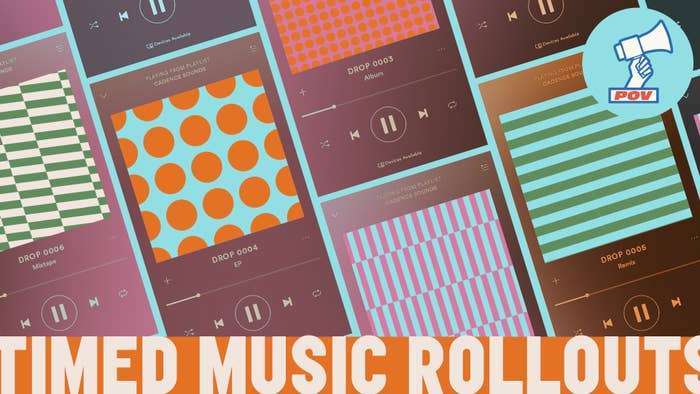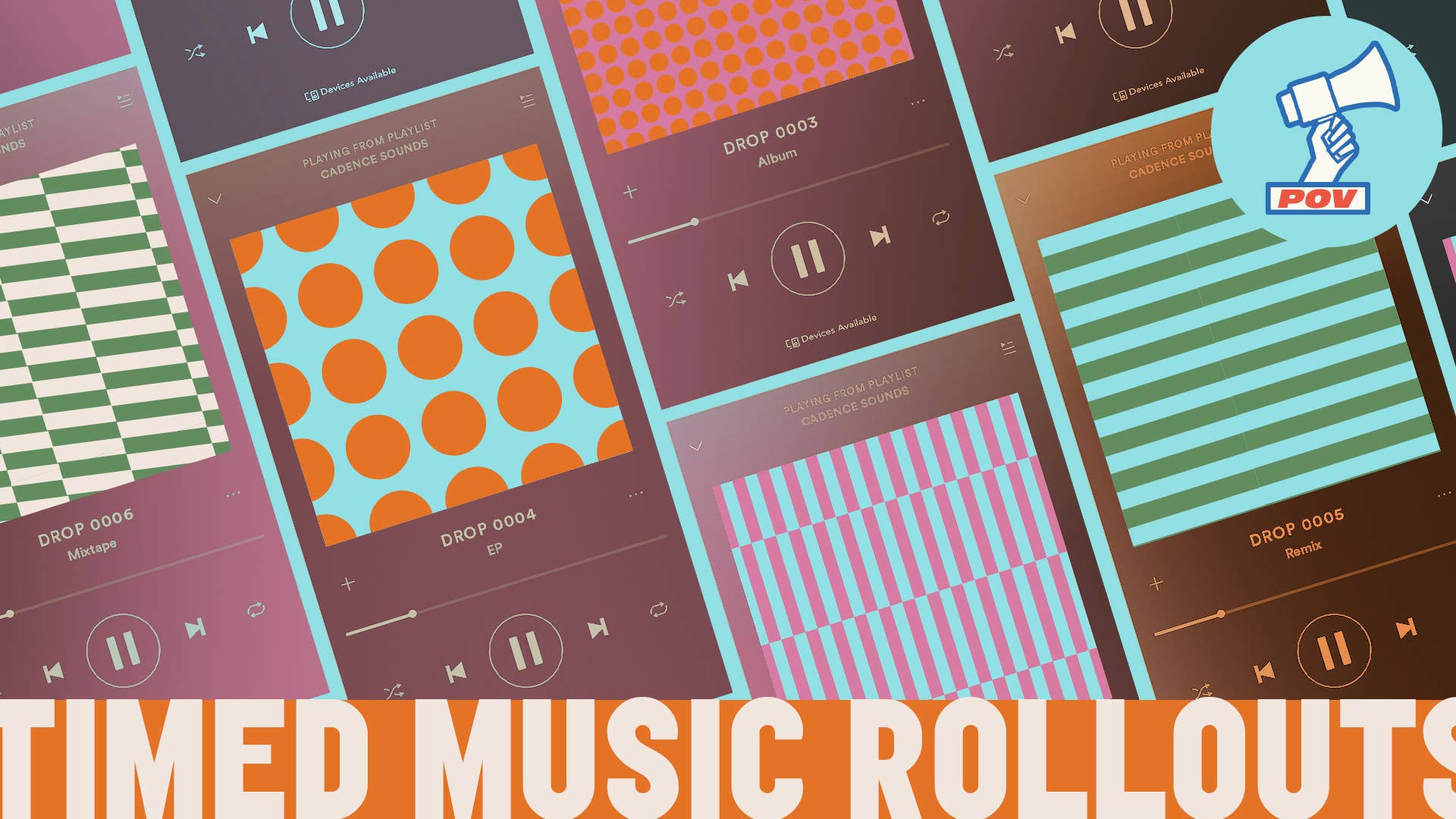
POV is a recurring first-person column wherein Complex employees have the opportunity to express their unique perspectives on an array of topics. In this column, Alec Friedman (associate director, business development) discusses the process of breaking new artists in a crowded, shifting record industry.
It’s 2021, and any artists hoping to get their music to the masses should be considering and catering to today’s climate and landscape. As the founder of Redfoot Projects, a company that develops music-focused brands, I think about this all the time. For some, the goal of a release is a moment for freedom of expression. But if your aim is to develop a listener base, you’ll want to pay attention to the cadence with which your music rolls out. And here, we’ll look at three approaches: the singles route, the album route, and the hybrid, which sits between the two.
Singles
We can agree that repetition breeds muscle memory. Think of how a professional basketball player trains by putting up however many foul shots a day to land that impressive free-throw percentage. You can train your fan base to participate in your releases in the same way. Consistency is key here. The artist who continuously puts their name and brand in front of audiences both new and established creates fans who engage in an algorithmic flow that sustains itself over time, creating a demand for more.
If I were asked to use a single metric to measure a new or emerging artist’s momentum (or lack thereof), I would tell you to keep an eye on their Spotify monthly listener number. Data varies across the internet, and these numbers continue to fluctuate, but Spotify remains the largest music-streaming service in the world. I choose this number because, within the artist discovery landscape, it goes beyond song streams to measure an artist’s consistency, growth, and streaming retention among fans. This is the group of listeners paying the most attention to your releases, and your goal as you emerge is to see that metric increase. If you are able to put out singles on as close to a monthly basis as possible, this should, in theory, continually trend upward.
Catering to a singles market lets you, as an artist, present a digestible product, especially if your sound can excite a new listener quickly. Some songs are more streamable than others. Releasing singles allows artists to evaluate the performance of a song by leveraging the data available, which helps in deciding when it’s appropriate to scale up and accelerate marketing toward a song or continue pouring resources into a record, versus perhaps moving onto the next single. This also becomes more cost-efficient for marketing.
Catering to a singles market lets you, as an artist, present a digestible product, especially if your sound can excite a new listener quickly.
A cadence of single releases also creates a digestible library of music for new listeners to dive into, and the larger the back catalog of songs they have to stream, the more opportunity there is to showcase why you’ve earned superfans. Full-length projects can theoretically provide a similar deep library effect if they’re marketed correctly, but the difference with a singles model is the ability to give each release the time for some TLC while it’s new.
If you’re releasing as close to one song a month as you can, naturally you will have more releases than if you were to drop a singular body of work. You have the opportunity to work more intimately with your target platforms. Give an exclusive for release “A” to publication “X,” then give release “B” a feature with platform “Y,” and so on.
Albums
The strongest advantage of an album is its ability to paint any particular picture you desire via a cohesive and all encompassing theme and aesthetic. When listeners enter your project, they should feel like you’ve created a whole new world for them. Albums like Kendrick Lamar’s good kid, m.A.A.d city, Travis Scott’s Rodeo and ASTROWORLD, and Tyler, the Creator’s IGOR all offer unique experiences that carry the listener through the entire project.
These albums are obviously a high bar for anyone. But for any album, the best approach is to commit to promoting the body of work over a long period. This is typically done in stages driven by single campaigns. You might run a single, two, or even three, prior to the release of the project, followed by a campaign for the album itself, and then mine the work for more singles. The idea is to shine a new light on deserving records. In determining which to market as singles, the album release also provides the opportunity to leverage data. Which songs are performing the best organically might be the clearest identifier. As fans, we’ve all had the feeling of loving a particular deep cut on an album and getting excited when it gets a push.
Touring is also essential. This is an opportunity to further your theme in how you brand your tour, design your staging, etc., regardless of budget. For example, I saw The-Dream’s tour for Sextape, which highlighted his identity as an artist; his tour staging was just him, his DJ, and one dancer on a pole with visuals in the back. It was simple, creative, and memorable.
With a tour, less is sometimes more. You can perform just three to five dates and still call it a tour if it’s announced and branded correctly. I’d rather have an artist play fewer shows, and focus the team’s efforts on ensuring those rooms are filled with quality eyes and ears that can convert to real fans, versus playing a heavy schedule of less impactful dates. There’s also something to be said for creating an aura that fans want to be a part of, where an artist can only be experienced a handful of times as they rise and fans can brag about how early into your career they saw you live at an intimate venue.
I would say the largest disadvantage to taking the album approach, especially early in a career, would be that, in the streaming landscape, most music is consumed in roughly a week’s time. From one New Music Friday to the next, you hope that you are able to win the attention of your fans before another one of their favorite artists drops. My opinion is simply that in today’s landscape, it’s putting a heavy amount up to chance to drop a longer project and expect the replay value. Even if you can stretch it to a full month’s worth of streaming, do you have 11 months of activity ready to retain your new audience? And given how streaming platforms’ algorithms work, it’s important to understand the value of new material.
Of course, the playing field isn’t exactly level, and for star-level talent, the opposite way of thinking can apply. Major artists—the Kanyes, Jay-Zs, and Kendricks of the world—have created such a strong demand for their music that fans will stream lengthy albums from top to bottom. They have the ability to set record-breaking marks and maximize monetization; this is why Drake’s 2018 Scorpion project is a “double album” of 25 songs or why Migos went from 13 songs on the Culture album to 24 on Culture 2 just one year later.
The Hybrid
There’s also a compromise between these two approaches. Artists can cater to the marketplace by delivering more than a single and less than an album in a few ways.
Small “packs” of music are becoming more popular. There’s no set length, but let’s say you drop two to three songs at a time. This can showcase the variety in your sound and show you what your fans are gravitating toward, giving you the opportunity to experiment before you take the next step.
EPs tend to be in the four-to-six-song range. My personal opinion is that it comes down to the question of how much your audience really wants and how well your team can support that slightly wider release. Are the additional songs worth it? For new artists, each release must feed momentum into the next, and the choice you make will shape your release calendar.
An approach that I find interesting and that also checks a nice amount of boxes is to focus on the singles model in a deep-dive fashion, and then package those existing singles with two to three new songs, and present it all together as a thematic album.Theophilus London did exactly this with Bebey, a 13-song project with, by my count, only four new tracks that weren’t at least previewed at some point. As a project that combines familiar and new materials, Bebey comes together nicely.
Another increasingly popular move flips the script on this concept by way of a deluxe release—a quick follow-up to an album with a version featuring new songs or remixes. Lil Uzi Vert and Justin Bieber’s latest projects, Eternal Atake and Justice, are strong examples of this approach.
The Takeaway
Every project is different and should be treated as such. But there’s one principle that I believe applies to all artists: crawl, walk, run—and then sprint.
Your strategy here is to seize the moment and make it last.
The crawl in that sentence is the singles model—releasing music frequently and building your monthly listeners to create a singles pool. It’s one song at a time, which should be simple enough, but I’ve consistently seen artists try to run before they’re able to deliver on a consistent basis. This is when you and your team should learn the dynamics of releases.
The walk is the hybrid and in-between scenario. Now you’ve built a semi-significant buzz from sticking with the singles model, and fans are ready for just a bit more. Give them more, all of it built around your identity, in the form of small packs of music or a project collecting the singles you’ve released. Then, as you find your footing, aim to perform live and branch out into merchandise, activations, and more.
Running and sprinting are album mode, when you’re at a star-to-superstar level and you’re putting out as many songs as possible to meet the streaming demand. You’re maximizing every opportunity: tours, merch, features, and more. Your strategy here is to seize the moment and make it last. The biggest artists of the moment are usually the ones working the hardest in the industry. Why? They have the most to do because their time is now.
But regardless of where you are, continue to push yourself and your team, look at yourself critically, and raise the bar accordingly. See the light at the end of the tunnel, even if others sometimes can’t. You’ll be running toward it soon enough.

